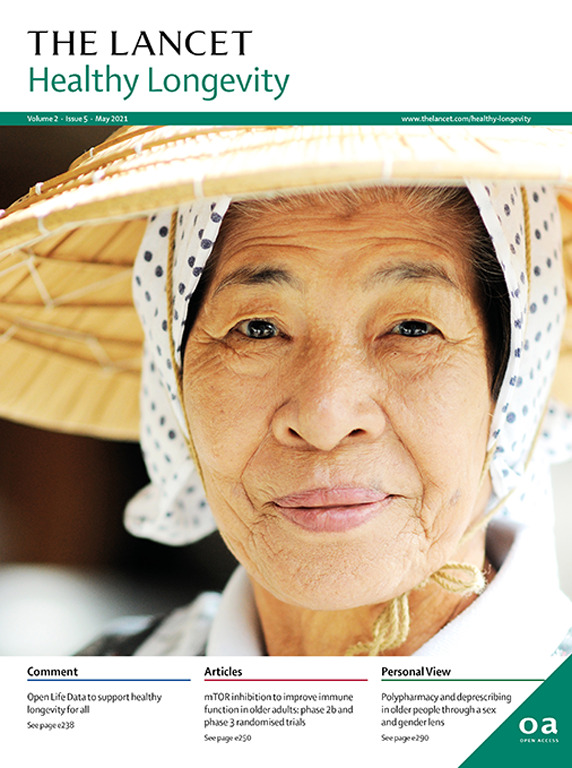Factors related to blood-based biomarkers for neurodegenerative diseases and their intergenerational associations in the Young Finns Study: a cohort study
IF 14.6
Q1 GERIATRICS & GERONTOLOGY
引用次数: 0
Abstract
Background
Blood-based biomarkers (BBM) of neurodegenerative diseases are emerging as cost-effective tools in the differential diagnostics of Alzheimer’s disease and other dementias. Scarce data exist about factors explaining BBM variation in population-based cohorts, and their intergenerational associations are unknown. This study aimed to characterise BBM distributions among a population-based cohort, investigate the association of a wide array of factors with BBM both in midlife and old age, and investigate intergenerational associations of BBM.
Methods
We measured BBM detecting amyloid β and tau pathologies, including amyloid β42, amyloid β40, and phosphorylated Tau (pTau)-217, as well as glial fibrillary acidic protein (GFAP) and neurofilament light chain (NfL) in the multigenerational Young Finns Study participants (n=1237, age 41–56 years) and their parents (n=814, age 59–90 years) using the Quanterix Simoa HD-X analyser. Standard statistical methods were used to examine the associations between BBM and age, sex, genetic factors, a plethora of cardiometabolic markers, liver and kidney function, and lifestyle factors, as well as their intergenerational associations.
Findings
Increased age was associated with adverse BBM concentrations. Of the various investigated factors, the most robust associations towards adverse BBM concentration were found for APOE ε4 carrier status among parents (amyloid β42:40 ratio, pTau-217, and GFAP) and high serum creatinine concentration in both generations (pTau-217, GFAP, and NfL). Several factors related to glucose metabolism and dyslipidaemia were negatively associated with all BBM, but adjusting for BMI diluted many of these associations. Statistically significant intergenerational correlations ranged from 0·20 to 0·33 and were mostly observed between mothers and offspring in pTau-217, GFAP, and NfL. No intergenerational correlations existed in amyloid β42:40 ratio.
Interpretation
We identified several factors that might influence BBM concentrations, parental transmission being one of them. For reliable use of BBM in clinical practice, it is important to identify which factors directly link to amyloid β and tau pathology and which factors influence BBM concentrations due to other physiological processes.
Funding
Research Council of Finland, Social Insurance Institution of Finland, Competitive State Research Financing of the Expert Responsibility area of the Kuopio, Tampere and Turku University Hospitals, Juho Vainio Foundation, Paavo Nurmi Foundation, Finnish Foundation for Cardiovascular Research, Finnish Cultural Foundation, The Sigrid Juselius Foundation, Tampere Tuberculosis Foundation, Emil Aaltonen Foundation, Yrjö Jahnsson Foundation, Signe and Ane Gyllenberg Foundation, Jenny and Antti Wihuri Foundation, Diabetes Research Foundation of the Finnish Diabetes Association, EU Horizon 2020, European Research Council, Tampere University Hospital Supporting Foundation, Finnish Society of Clinical Chemistry, the Jane and Aatos Erkko Foundation, and the Finnish Brain Foundation.
芬兰青年研究中神经退行性疾病的血液生物标志物相关因素及其代际关联:一项队列研究
神经退行性疾病的血液生物标志物(BBM)正在成为阿尔茨海默病和其他痴呆症鉴别诊断的经济有效工具。在以人群为基础的队列中,关于解释BBM变异的因素的数据很少,而且它们的代际关系是未知的。本研究旨在描述以人群为基础的队列中BBM的分布特征,调查各种因素与中年和老年BBM的关联,并调查BBM的代际关联。方法我们使用Quanterix Simoa HD-X分析仪测量了多代年轻芬兰研究参与者(n=1237,年龄41-56岁)及其父母(n=814,年龄59-90岁)的BBM检测β淀粉样蛋白和tau病理,包括淀粉样蛋白β42、淀粉样蛋白β40和磷酸化tau (pTau)-217,以及胶质纤维酸性蛋白(GFAP)和神经丝轻链(NfL)。采用标准的统计方法来检查BBM与年龄、性别、遗传因素、大量心脏代谢标志物、肝肾功能和生活方式因素之间的关系,以及它们的代际关系。研究结果:年龄增加与不良BBM浓度相关。在研究的各种因素中,与不良BBM浓度最密切相关的是双亲APOE ε4携带状态(淀粉样蛋白β42:40比例、pTau-217和GFAP)和两代血清肌酐浓度高(pTau-217、GFAP和NfL)。与葡萄糖代谢和血脂异常相关的几个因素与所有BBM呈负相关,但对BMI进行调整稀释了许多这些关联。pTau-217、GFAP和NfL的代际相关性在0.20 ~ 0.33之间,主要存在于母亲和后代之间。淀粉样蛋白β42:40比例不存在代际相关性。我们确定了几个可能影响BBM浓度的因素,亲代传播是其中之一。为了在临床实践中可靠地使用BBM,重要的是确定哪些因素与β淀粉样蛋白和tau病理直接相关,以及哪些因素由于其他生理过程影响BBM浓度。资助:芬兰研究理事会、芬兰社会保险机构、库奥皮奥、坦佩雷和图尔库大学医院专家责任领域国家竞争研究资助、Juho Vainio基金会、Paavo Nurmi基金会、芬兰心血管研究基金会、芬兰文化基金会、Sigrid Juselius基金会、坦佩雷结核病基金会、Emil Aaltonen基金会、Yrjö Jahnsson基金会、Signe和Ane Gyllenberg基金会、Jenny and Antti Wihuri基金会、芬兰糖尿病协会糖尿病研究基金会、EU Horizon 2020、欧洲研究理事会、坦佩雷大学医院支持基金会、芬兰临床化学学会、Jane and Aatos Erkko基金会和芬兰大脑基金会。
本文章由计算机程序翻译,如有差异,请以英文原文为准。
求助全文
约1分钟内获得全文
求助全文
来源期刊

Lancet Healthy Longevity
GERIATRICS & GERONTOLOGY-
CiteScore
16.30
自引率
2.30%
发文量
192
审稿时长
12 weeks
期刊介绍:
The Lancet Healthy Longevity, a gold open-access journal, focuses on clinically-relevant longevity and healthy aging research. It covers early-stage clinical research on aging mechanisms, epidemiological studies, and societal research on changing populations. The journal includes clinical trials across disciplines, particularly in gerontology and age-specific clinical guidelines. In line with the Lancet family tradition, it advocates for the rights of all to healthy lives, emphasizing original research likely to impact clinical practice or thinking. Clinical and policy reviews also contribute to shaping the discourse in this rapidly growing discipline.
 求助内容:
求助内容: 应助结果提醒方式:
应助结果提醒方式:


